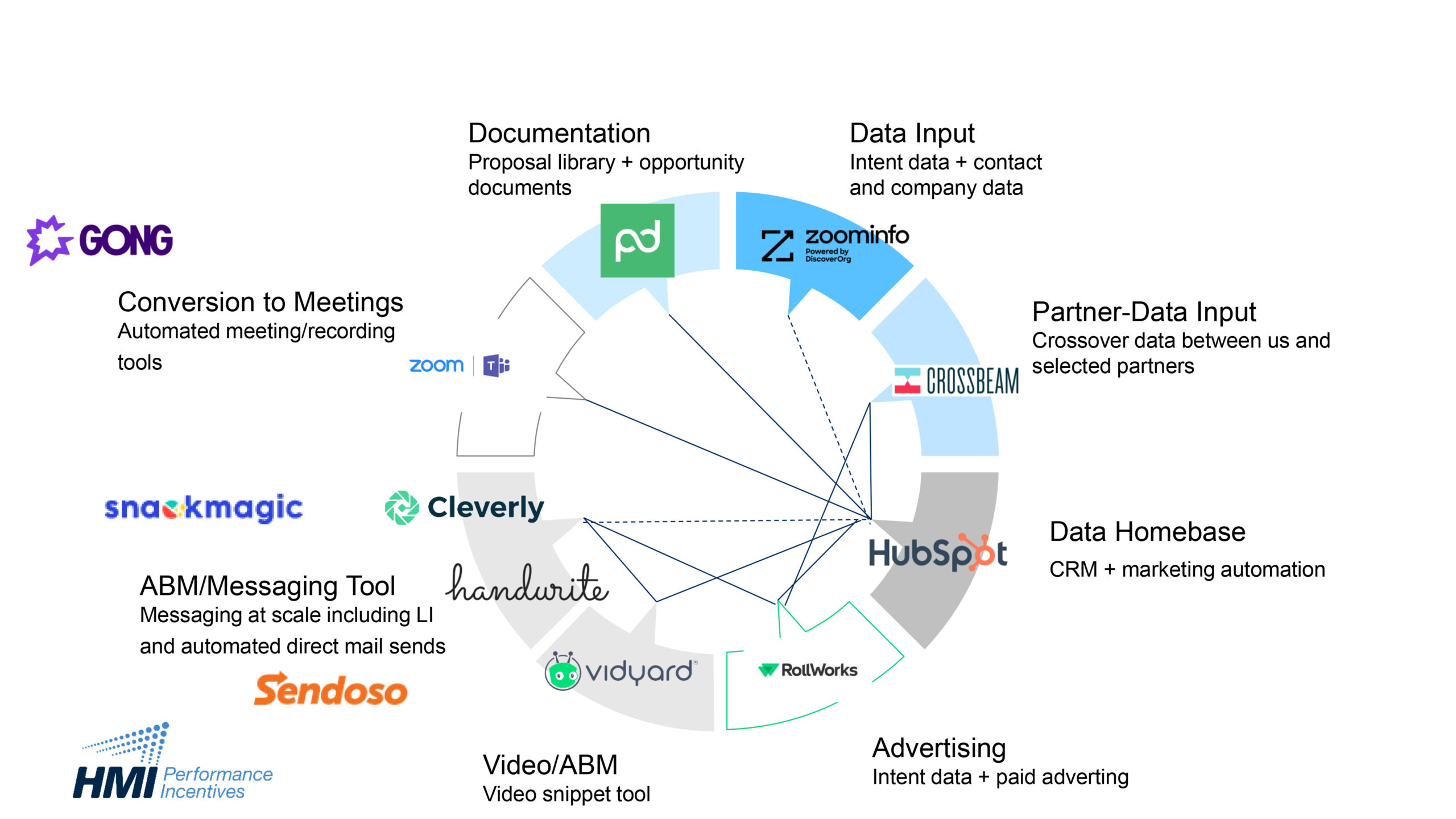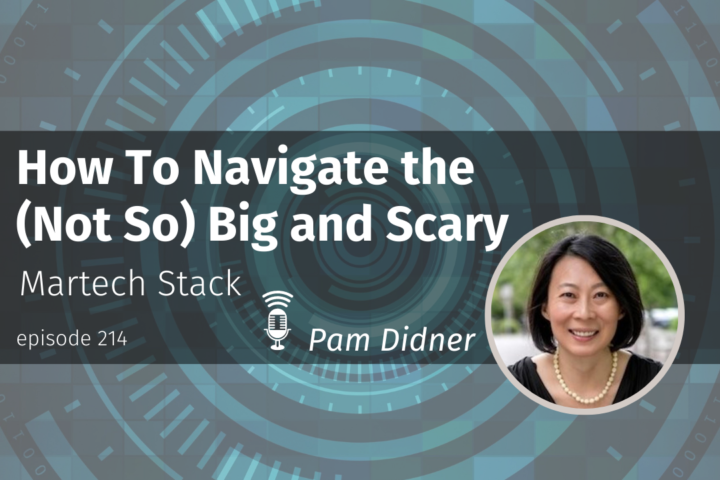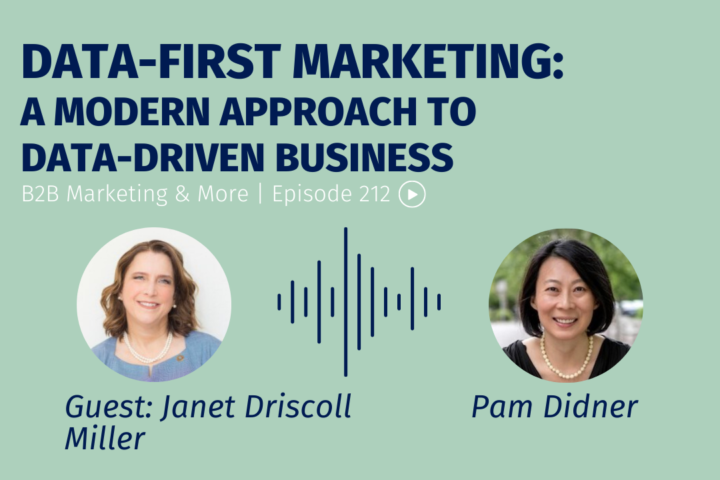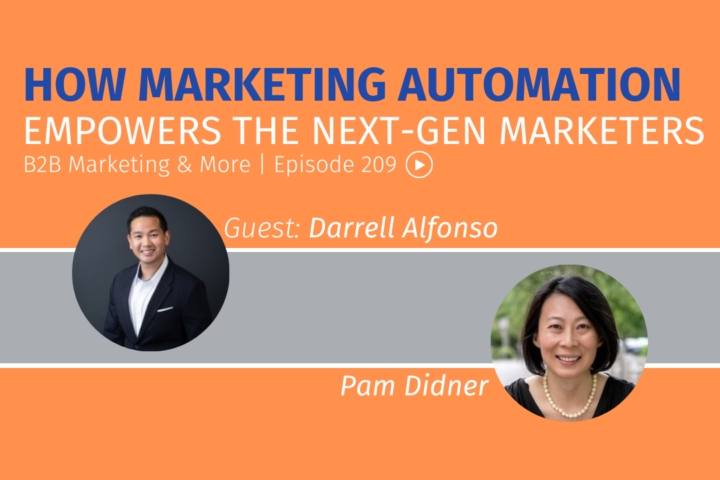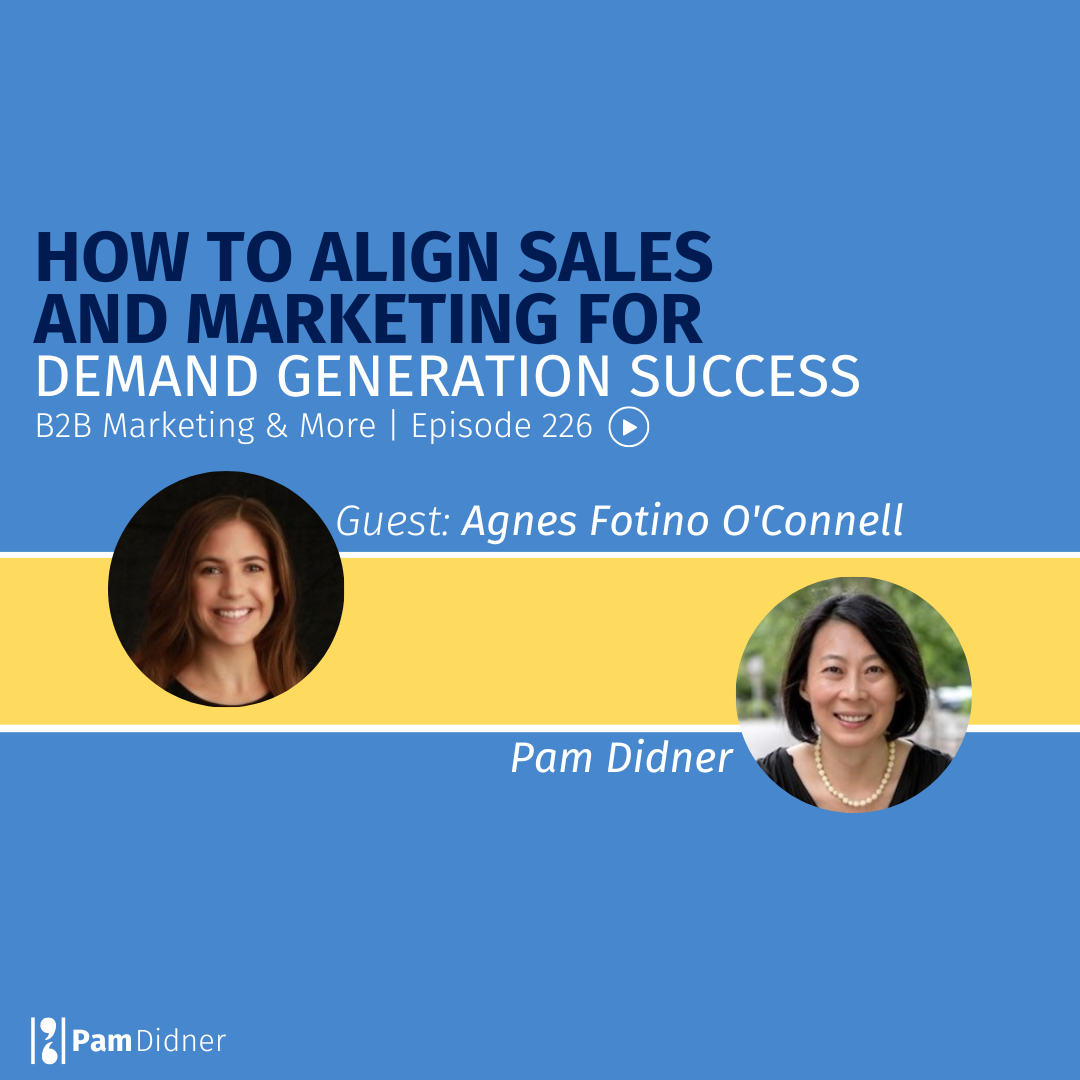
Welcome to another episode of B2B Marketing and More with Pam Didner. I haven’t done a lot of episodes lately. That’s because I was busy writing a novel! Yes, I’m writing a novel. I will tell you more little later in a different episode.
However, for this episode, I have a special guest for you, Agnes Fotino O’Connell, a for HMI Performance Incentive.
We met at the B2BMX Conference in February. Agnes came to my workshop, and we hit it off right there. At that time, I was talking about sales enablement. Agnes told me that’s something she’s been doing for quite some time now.
So, I invited Agnes to my podcast to talk specifically about a couple of things: how to better support sales and how to align sales and marketing for demand generation success.
In this episode:
- Learn more about HMI Performance Incentive company and what they do.
- How to incentivize channel partners to reach the sales goal?
- How to find sales advocates within a company?
- What can B2B marketers do to better optimize their marketing campaigns?
- What is the short-term KPI versus the long tail?
- How to tie metrics to pipeline opportunity?
- What are the “three moments” in identifying demand generation?
- Which tools are good to have in a tech stack to use and unravel some of the key insights?
- How to use and augment the flywheel model?
- What is the secret of customer loyalty and demand generation success?
Quotes From The Episode:
“I’ve put up and stood up a program at HMI that is the HMI Sales and Marketing Excellence Program, which allows young grads to come in and see and experience both sides of the house, everything from biz dev to field marketing, to social, to digital and so on. It’s really important for your trajectory to understand how hard both roles are.”
“You really have to put your trust in sales’ hands and help– really help them help you get the job done. Go find that top salesperson and make them your advocate. Show them how your campaign – whatever you wanna roll out as a marketer – will make them successful.”
HMI Performance Incentive Flywheel
—————
Enjoy the podcast? Subscribe to the show on your favorite podcast platform, leave a 5-star review, and subscribe to Apple Podcasts.
If you prefer watching a video, I also have a YouTube Channel; check it out and subscribe.
If you want to chat, contact me on any social media channels or email me at hello@pamdidner.com. You can also join my Facebook community: Build Your Marketing Skills to Get Ahead.
To expand your knowledge about martech, sales enablement and demand generation success, check out some of my previous podcast episodes, blog posts, and video.
Podcast episodes
How to Enable Sales and Marketing Alignment Within an Enterprise
Sales and Marketing Alignment for Startups
The Myth of the Empowered Buyer
Blog post
Six Ways to Start Subject Matter Experts Thinking Like Content Marketers
Sales Enablement: How To Boost Your Communication with Sales in 6 Easy Steps
Video
5 Questions Marketer Can Ask to Understand a Sales Team
TRANSCRIPT
Pam Didner: Hello, everyone. Welcome to another episode of B2B Marketing and More with Pam Didner. Yay. I haven’t done a lot of episodes lately. That’s because I was busy, I don’t know, writing a novel! Yes, I’m writing a novel. I will tell you more little later in a different episode. Still, today I have a special guest for you, and she is a Director of Demand Generation for HMI Performance Incentive. And she is Agnes Fotino O’Connell. Hey Agnes, so happy to have you here.
Agnes Fotino O’Connell: Pam, I’m so excited to be here. Thanks for having me.
Pam Didner: We met at the B2BMX in February. Agnes came to my workshop, and we had a great time. We hit it off right there, and at that time, I was talking about sales enablement. Agnes told me specifically that that’s something that she has been doing and also is doing it.
So that’s why I invited Agnes to the podcast to talk about specifically a couple of things: how to better support sales and sales through demand gen, and how to achieve demand generation success.
Before we get started, Agnes, talk to us about your job and also what does your company do?
Agnes Fotino O’Connell: Yeah, sure. HMI Performance Incentives is a leading incentive strategy company, helping companies with a broad spectrum of needs and challenges, motivate both their direct and indirect sales teams, customers, et cetera, to meet sales goals, increase loyalty, change behaviors, and everything else that you come to know and love about customer loyalty and incentive strategies.
Pam Didner: If I’m not mistaken, I think the incentive program you set up is very much tailored for channel partners, such as the wholesalers working directly with their distributors and the dealers and the value-added resellers, assisting integrators. It’s basically like a channel marketing tool. Then you use that to incentivize many channel partners to reach the sales goal.
Can you give us a very specific example of that?
Agnes Fotino O’Connell: Yeah, sure. We might work with a large wholesaler. Let’s say they were in the building material space. They’re a company trying to go after the contractor or the dealer, and we’d help them do a couple things. One, we’d help them create a customer loyalty program that might go after what we call the “middle 60” of customers, who are always with you, and you know what to expect from them. And then it might also help target the top 20% of their customers–the customers that typically bring 80% of their business.
And we might put together some form of group incentive travel trip for those top customers, helping build a moat around them, helping them diffuse from competition taking them, and again, helping grow that middle 60 to do more than they’ve historically done with them.
Pam Didner: So it is whatever your customer wants to incentivize, and you build a program. You can track the performance and then award whoever reached that specific target.
Agnes Fotino O’Connell: You’re spot on for an incentive marketing agency, Pam.
Pam Didner: Very, very good. So then talk to us now. You have told us specifically in terms of what your company has done.
Your role is a Director of demand gen, and I remember when I was talking to you, and you said you’ve been on the sales side, you’ve been on the marketing side.
Before I talk to you about demand gen and achieving demand generation success, can you talk to us a little bit about being on the sales side and marketing side for any B2B marketers who would like to support sales? Do you have any specific tips, tricks, or advice?
Agnes Fotino O’Connell: I think you must understand what’s important to the sales folks at myriad levels. Right. And Pam, I think you gave some amazing advice during your workshop at the B2B MX. About, you know, finding your sales advocates, right? Finding those folks who will help you make an imprint, make a case study of what you wanna accomplish as a marketer.
You really have to put your trust in sales’ hands and help– really help them help you get the job done. So what I like to say is, go find that top salesperson and make them your advocate. Show them how your campaign- whatever you wanna roll out as a marketer- will make them successful. Get them on board, and then go find someone, maybe more in the middle, right? Someone meeting and exceeding their KPIs, but maybe not a rock star. And then onboard them onto your plan. And then when you have, you know, those two or four, six people on board, you’re gonna be pretty untouchable with whatever you try to roll out to your sales work.
Pam Didner: So the bottom line is getting to know them.
And it started with a small group of people who might be your ally. Build your own tribe. Try first and show them what kind of value you would add, then take it step by step.
Agnes Fotino O’Connell As marketers, we talk about trialing, right, piloting and looking at data. And I think a lot of times, marketers forget to do that internally. We only tend to look at doing that externally, and it’s kinda like, “Hey, take a moment, pause, pilot internally, see what the reaction is, and then go run that external.”
Pam Didner: I love it. Love it. That said, I will touch on the next topic, demand gen. So demand generation is hard. Aligning marketing and sales for demand generation success is hard. I mean, I’ve been doing demand generation myself. I mean, even trying to build my own pipeline; is hard. Not to mention that you work for a company and must sell products. Which means to align marketing and sales is a must to achieve demand generation success.
And the many B2B marketers I have talked to often have demand gen targets every month. It’s actually very, very hard. Do you have a holy grail or any kind of campaign or anything that you do to help people understand what they can do to better optimize their marketing campaigns?
Agnes Fotino O’Connell: That’s a great question and a loaded one. You know, I think right now we’ve moved away from a lot of what I would call short-term KPIs, and we’re really looking at the long tail and–
Pam Didner: So, can you clarify that? Sorry to interrupt. What is the short-term KPI versus the long tail? Can you be very specific about it?
Agnes Fotino O’Connell: In our business, we have a long selling cycle, like hopefully most B2B marketers are experiencing right now. Yeah, we’re talking about 18 to 24-month sales cycles on the long end of it, really high-end, high dollar value amounts.
So for me, looking at monthly MQLs is not a great output of what we expect in that quarter. We spend a lot of our time and attention looking at thought leadership, the sorts of downloads, and the sorts of referral traffic we’re getting from that. Suppose we can get pings on how that’s coming up in conversations and how people leverage what we’re putting out. In that case, there is our best metric right now to understand. We tend to not look at as many leads per month–net new MQLs–we’re really looking at our thought leadership content-creating opportunities.
Pam Didner: So does that mean that many of the metrics you are responsible for are tied to pipeline opportunity driven?
Agnes Fotino O’Connell: 100% of our metrics.
Pam Didner: What do you do to quantify that pipeline opportunity through, say, referral traffic or through like thought leadership content? Because I feel there’s a gap there is in terms of content consumption and leadership play. Suddenly there’s a pipeline activity, so there’s a gap. How do you connect that gap and bring that content consumption or thought leadership play down?
Agnes Fotino O’Connell: We’re doing something very simple, capturing it at opportunity state–essentially understanding from the salesperson’s perspective how and why this opportunity turned into a deal? And we’re asking them in the opportunity form to state it. And it’s really interesting the number of people essentially saying, “Hey, I feel like this was demand gen oriented for these couple of reasons.” So our goals are to have essentially 50% of our opportunities be self-validated from sales, saying this was demand gen who helped me create this.”
And then, you can start to look backwards in the customer file, if you will, or in the contact card to understand where they first came into our database.
When did they start to engage with us? And then when did they turn into an opportunity? I think the future state is looking at those three moments in identifying demand generation, at least a portion responsible for those important turns.
Pam Didner: I love you identify the three moments as when they come in and when they probably become opportunities. So based on your experience and working backwards. What are some of the channel, from your perspective, is most common to capture that moment that possibly can train into pipeline opportunity? How can they help with demand generation success?
What kind of campaign tactics tend to drive to that specific point?
Agnes Fotino O’Connell: For us, it’s a lot of referral traffic from third-party subject matter experts. I can give you an example. If we see that a contact is constantly attending one of our subject matter expert partner’s webinars on a topic we’re sponsoring, it’s essentially a form of intent data, right? Yeah. We can start to aggregate, “OK, there’s something here, right? Their ears are up. They’re looking for something in this. Can we start to feed them a more aggregated, essentially marketing plan of and around that topic?” And then can we start to create a conversation essentially using ABM tied to that?
Pam Didner: Yep. That makes a lot of sense. So you actually watch data like a hawk, I assume.
Agnes Fotino O’Connell: Yes, we’re a small team and feisty. So you know, when you have a small team–as I’m sure many B2B marketers can relate to right now–data’s your best friend. To do things at scale, you must be data-driven right now.
Pam Didner: I 100% agree. So can you talk to us about what some of the tools that you use to actually unravel some of the key insights?
Agnes Fotino O’Connell: Right now, we’re pretty excited about our tech stack. I think a lot of things are kind of coming back in style right now. You know, at B2B MX, we heard a lot about direct mail. We’re trying to add a few different tools for that into our marketing stack right now to try and understand behaviors; we have two instances of intent data formally stood up, one at the top of the funnel and one at the bottom using our friends at Rollworks.
We’re also trying to find a partner for more of that middle intent data where we just have some listening out in the universe. We’re big advocates of HubSpot. We use them for both our CRM and our marketing automation. From the send standpoint, we’ve just set up an integration with a very cool tool called Hand Write, which sends handwritten notes from our sales team after they meet in person, automated at a conference. So we’re able to track that. It’ll have a QR code to send them to some of our resources put on it and a QR to their business card that we can track on the back end.
We’re obviously doing a ton with QR codes and trying to leverage that as another source of intent data.
We’ve played around with Gong as a great marketing tool. For your listeners, it is an incredible sales tracking tool that listens in, using machine learning and AI to make sales calls. It’s a marketing tool. So we’ve started to leverage some of the insight it provides us. But at the end of the day, it’s really putting people right now to look at those moments that were training opportunities and then try to scale those moments.
Pam Didner: So you brought up a lot of tools. Many marketers are overwhelmed because they feel they must add different tools at different stages. And all of a sudden, your Martech stack becomes pretty complicated. And to some extent, that’s inevitable. You must use different tools at different times, and no one fits all.
And also, depending on what kind of campaigns you are running and different channels, you might need to use different listening tools. So I want to make sure everybody understands that. When Agnes was talking about different tools she needs to use, that’s probably based on the process, workflow, or marketing channels she is utilizing.
You have to understand and talk to the vendors and see if that fits your Martech stack or your workflow.
So it may fit, or it may not. But note that you understand what those tools will do, and then you can decide if that works for you. So for the longest time, When I listened to a tool, I said, “oh my God, Agnes, you used that tool. You know what, I probably should use it too, right?” But then later, I found out I needed to evaluate that tool before I could determine if that actually applies to me. But there was a time I was like, “you know what? Everybody’s using it. I should too.” But that’s not necessarily the case. So I wanna make sure you understand that? Go ahead, Agnes.
Agnes Fotino O’Connell: If I can, you know, I’m passionate about it. I love giving people the next tool sort of recommendations. And something I’m coming out, actually just yesterday, with one of my team members is a Martech stack audit.
Pam Didner: Audit? OK, got it.
Agnes Fotino O’Connell: We look at how all of our systems work together, and if you don’t already have a flywheel of this, I will look at it, and it’s gonna become, hopefully, a pretty complex flywheel because your different tools will speak to one another and you should draw that out.
So just start drawing dotted or hard lines if it’s a strong integration.
And then you’ll be able to show and explain internally how everything works, which is really helpful for both your team and the sales team, right? To show them, “Hey, here’s how everything can work together. Here’s what you can use, what I can use, and what we can both use.”
And then what you could layer on top of that is where different tools layer in. So, for example, you could start to augment that flywheel to show here’s what we’re using at a lead level. Here’s what we’re using at an MQL level. Here’s what we’re using at an SQL level. Here are tools that we use everywhere.
And then you can start a part of this. Maybe an ongoing deck is how I do it, at least, that’s updated, that is, “Hey, here are some tools that are not the right fit for us right now, but I’ve evaluated, I understand their pricing, and I understand what they can do.” And then you just put a slide in for them with some of your raw notes. That way, when a gap does come up, you’re not scrambling to go on G2 or wherever you might go for your insights. It’s, “oh, I think I already did something there, or let me see if I’ve already evaluated that.” Flip through your deck, and it’s waiting for you.
Pam Didner: I love it. So do you have that flywheel you can share with us?
Agnes Fotino O’Connell: Yeah, I can send it out after this. I would love that.
Pam Didner: And I would actually add that to the video. Yeah. And uh, so people can see it.
Agnes Fotino O’Connell Yeah, I’m happy to.
Pam Didner: Yay. I love it. So, last question: you’ve been working on both the sales and marketing sides. Have you had any advice for anyone interested, kind of moving back and forth between sales and marketing, you know, any kind of career advice that you have for them?
Agnes Fotino O’Connell My first thought would be to do both, and I truly stand behind that, and I don’t just stand behind.
I put it into action. I’ve put up and stood up a program at HMI that is the HMI Sales and Marketing Excellence Program, which allows young grads to come in and see and experience both sides of the house, everything from biz dev to field marketing, to social, to digital and so on.
But I, you know, I think it’s really important for your trajectory to understand how hard both roles are. It’s an amazing skill set to understand what it’s like to go, you know, do the role of biz dev, making those 50-100 calls every day. And I will say, in turn, you understand then. I think I have a higher level of appreciation for when you need those marketing assets at your disposal to send out how great those are to have and how to design them to be a better fit for the actual salespeople using them and to the recipients.
So, do both if you can. I think it’ll make you a more well-rounded individual going into either your sales or marketing career on whatever side you end up in. Or you could be like me and just maybe hover somewhere in the middle if you find an organization that will let you.
Pam Didner: Well said. I have nothing to add except I don’t do two at the same time but try each one at a different time. So you really don’t want to be Michelle Yeoh. Like, be everywhere, anytime at the same time.
Agnes Fotino O’Connell: I couldn’t agree.
Pam Didner: So, one last fun question. So what show are you binge-watching right now?
Agnes Fotino O’Connell: I’ve been watching a bit of “Top Chef,” but the really old seasons of Gordon Ramsey, which has been fun and “Hell’s Kitchen.” But I’m reading some really good books right now, Pam, if you’re interested.
Pam Didner: What is it?
Agnes Fotino O’Connell: I’m rereading Thinking Fast and Slow, which is the best. And then, for a fun book, I read, When Life Gives You Lululemons.
Pam Didner: Love it.
Agnes Fotino O’Connell: What are you reading, Pam?
Pam Didner: Oh, I’m reading. I’m reading a drama. This is very dark. Gillian Flynn’s Sharp Objects.
My God, it’s so dark. After I read it, I was like, “you know what? I’m actually getting a little depressed.”
Agnes Fotino O’Connell: Maybe a light book after this, huh?
Pam Didner: Yeah, exactly. But that was like, I’m reading right now. I’m actually reading more and more fiction. I got away from business reading in the past two years. I guess I just need to take a break after 10 years. It was like, you know, “I’m done. Lemme read some fictional book.” Anyway. Hey, Agnes, it’s wonderful to have you. You share a lot of insight, and by the way, it was so wonderful to meet you at my workshop. It is such a great, great addition to have you at my workshop. We had a great time, right?
Agnes Fotino O’Connell: We sure did. Cannot recommend enough going to both B2BMX—I’ll give them a bit of a shout cause that was a really excellent conference–but also, if you have an opportunity to get to one of Pam’s workshops. It was incredible.
Truly lucky to sit in her grace there for like two and a half, three hours.
You don’t get many opportunities to learn like that from a marketing expert. Amazing Pam.
Pam Didner: I actually pay Agnes to say that. (both laugh) Just kidding. Just kidding. But I’m actually doing a very similar workshop about sales enablement and how the marketing sales op, Biz op, even, uh, marketing ops, and what you can do to better support sales in a changing environment, Ignite Chicago on May 23rd. So if you are interested, check that out or contact me. And by the way, bring any questions to the workshop. I do answer them. Seriously, I do.
Agnes Fotino O’Connell: The entire time. She answers them the entire time. It’s amazing.
Pam Didner: Alright. Hey Agnes, it’s wonderful, wonderful to have you here. Wish you the best of luck. Keep us posted about everything you are doing, and come back next time.
Agnes Fotino O’Connell Thanks, Pam. I appreciate it.
Pam Didner: If you want to see Agnes’ flywheel, look in this episode’s show notes or visit my website at pamdidner.com/podcasts, episode 226. See you next time, and let me know what do you do to achieve demand generation success.

